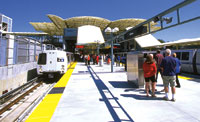...worldwide, says Sudhir Jambhekar, principal with local architects Fox and Fowle. The firm is part of the local preliminary engineering team led by DMJM+Harris and Arup.
 |
| Upkeep. While new plans thrive (above) chief engineer Crawford (below left) must maintain current subway.(Photos courtesy of MTA New York City Transit) |
Advanced tunneling techniques would allow construction of the Second Avenue Subway to be less disruptive than the cut-and-cover methods that created the existing lines, says Kenneth Griffin, the teams chief architect for station concepts and author of a book that examines subway design trends.
The team will complete preliminary engineering for a record of decision by years end for the entire line. MTA officials are reviewing requests for qualifications received earlier this month for a design-build contract to tunnel the first mile-long segment. Five teams submitted RFQs, says Joe Siano, MTA senior vice president. The contract, expected to be awarded in February, will take an estimated 42 months.
 |
Most tunneling of the twin 9.75-ft-dia bores will be done in hard rock some 60 ft deep. Six stations will be mined. Another 10 will be built with cut-and-cover methods due to varying elevations of softer soils. "The focus of the new construction is to minimize the impact on surface level," says Anil Parikh, MTA program manager. "TBM machines are so advanced that you can monitor movements every foot. That will minimize impact on buildings."
 Click here to view map
Click here to view map
The team is testing numerous technologies after studying new subways globally. Unlike New Yorks older stations, the Second Avenue lines stations will feature column-free spaces and ventilation systems that allow for containment of biochemical toxins and release of smoke. Engineers are testing the use of aluminum rail to save operating costs and energy.
Entrances will be integrated into existing buildings whenever possible, eliminating stairwells descending through sidewalks into stations. "Were now eliminating sidewalk gratings and putting fan plants in ancillary facilities for better drainage," says Parikh, noting a September heavy rainfall that disrupted service on existing lines.
|
The current capital budget provides $1 billion for the project, but "I need another $2.8 billion for the first segment," says Mysore Nagaraja, MTA Capital Construction Co. president.
Nagaraja also is planning another new subway project to extend the No. 7 line west from Times Square to the Javits Center. That project is to be funded by New York City. A state environmental impact statement is expected next month.
"We are preparing design-build packages for the tunnel," says Nagaraja. The project includes 7,000 ft of twin-bore tunnels and two stations.
In lower Manhattan, a record of decision is expected next month for a new transit center funded by 9/11-related federal redevelopment programs (ENR 2/17/03 p. 11). A final EIS for the $750-million Fulton Street station that will connect to the World Trade Center site was completed this month. The other new downtown subway project, the $400-million rehabilitation of South Ferry terminal, received five design-build proposals. One will be chosen next month, says Nagaraja.
The Second Avenue Subway and the East Side Access project that will bring Long Island Rail Road commuter trains eastward across Manhattan into Grand Central Terminal represent two of North Americas most ambitious tunneling projects. MTA is anticipating $4 billion in federal aid for the projects that will showcase the new era of rail construction. "We hope [Second Avenue] will still be relatively new on the systems 200th anniversary," says Parikh.
| In California, Plans For Subterranean Rail Work Continue
Despite political and funding uncertainties across the country, underground rail construction is progressing in cities like Seattle and Washington D.C. But belying its car-loving reputation, the bulk of proposed new heavy rail appears to be in California. Plans to extend Los Angeles 17.4-mile, $4.5-billion subway stalled in 1998 when voters approved a ballot measure forbidding use of county sales tax funds for subway work. But last month, city council members passed a resolution backing a $1-billion subway extension along Wilshire Boulevard. The council said it would endorse repealing both the 1998 measure and a 1986 law prohibiting use of federal funds for such a project. Other underground rail work is under way. Evansville, Ind.-based Traylor Bros. could start tunneling in late 2005 as a subcontractor to a local joint venture of Washington Group International, Obayashi Inc. and Shimmick Construction Co. In June, Los Angeles County Metropolitan Transportation Authority awarded the venture a $600.4-million contract for the $899-million eastside extension of the Metro Gold Line. Technically a light rail line, it will incorporate 1.7 miles of twin 22-ft-dia tunnels into its 6-mile alignment. Eli Choueiry, Metro deputy executive officer for construction management, says that unlike in previous contracts, the agency will specify use of a closed-face earth pressure balance TBM. Metro expects the machine, which specializes in loose, wet, alluvial soils, to reduce exposure and the risk "of having ground unravel on you," he says. San Jose-based Santa Clara County Valley Transportation Authority is going a step further. The agency will purchase its own TBM for 4.7 miles of twin tunnels along the 16.3-mile, $4.2-billion extension of Bay Area Rapid Transit to Milpitas, San Jose, and Santa Clara, says Jack Collins, VTA chief construction officer. "We dont want to take the risk" of leaving TBM design up to the contractor, "because we think we know the soil conditions better than any bidder coming in," Collins says. A contractor for the $400-million tunnel section should be chosen by early 2008, he says. In San Francisco, a local team of Parsons Brinckerhoff and PGH Wong Engineering Inc. plans to complete preliminary design next year for a 1.7-mile tunneled extension of its Muni Metro Third Street light rail line, including two underground stations. |


Post a comment to this article
Report Abusive Comment